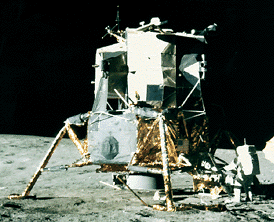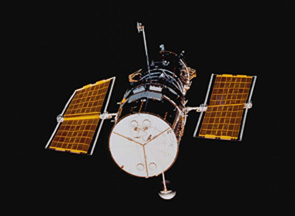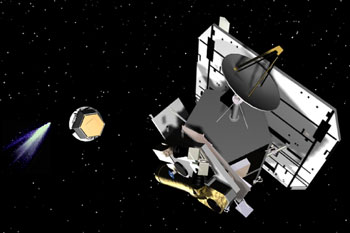Model of Surveyor 3 on a beach in California
Click on image for full size
NASA/JPL
Surveyor
The Surveyor missions of 1966 through 1968 were the next step in space travel to the Moon, following the Ranger missions. Their goal was to perform "soft" landings on the lunar surface, meaning that the spacecrafts would not crash and be destroyed.
Five of seven Surveyor missions were successful, landing safely on the moon, conducting soil analysis, and returning over 87,000 close-up photographs of lunar terrain. Parts of the Surveyor 3 spacecraft which landed in 1967 were even brought back to Earth by astronauts visiting the Moon 3 years later to study the effects of exposure to space environment.
From the Surveyor program we learned that the lunar surface is firm and can be walked on by astronauts, a feat accomplished by the Apollo missions.
You might also be interested in:

Scientists have found new evidence supporting a theory that ancient Mars was similar to our current Earth. Using a magnetometer, NASA's Mars Global Surveyor is finding magnetic field patterns on Mars'
...more
Driven by a recent surge in space research, the Apollo program hoped to add to the accomplishments of the Lunar Orbiter and Surveyor missions of the late 1960's. Apollo 11 was the first mission to succeed
...more
Apollo 12 survived a lightning strike during its launch on Nov. 14, 1969, and arrived at the Moon three days later. Astronauts Charles Conrad and Alan Bean descended to the surface, while Richard Gordon
...more
During 1966 through 1967, five identical Lunar Orbiter spacecrafts were launched, with the purpose of mapping the Moon's surface and finding smooth, level terrain, in preparation for the Apollo and Surveyor
...more
The Hubble Space Telescope (HST) was one of the most important exploration tools of the past two decades, and will continue to serve as a great resource well into the new millennium. The HST is credited
...more
Apollo 15 marked the start of a new series of missions from the Apollo space program, each capable of exploring more lunar terrain than ever before. Launched on July 26, 1971, Apollo 15 reached the Moon
...more
NASA chose Deep Impact to be part of a special series called the Discovery Program on July 7, 1999. In May 2001, Deep Impact was given the "go" from NASA to start with mission development. Deep Impact
...more















